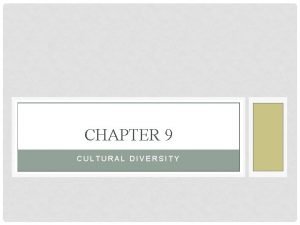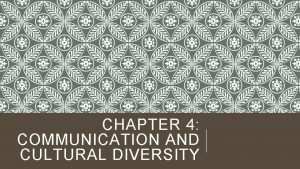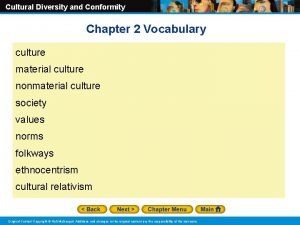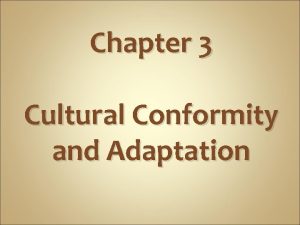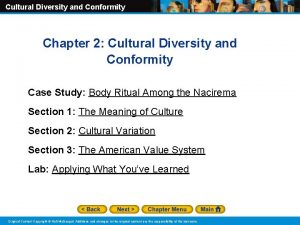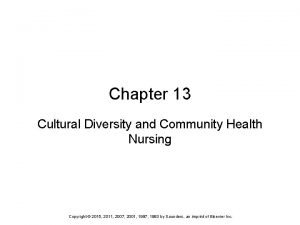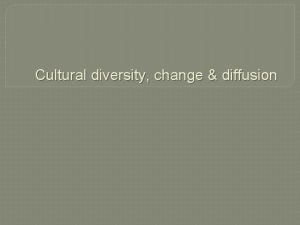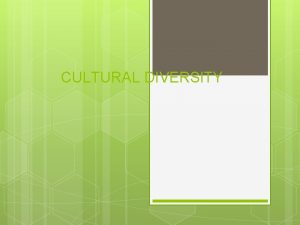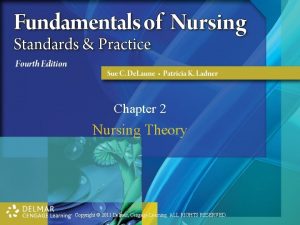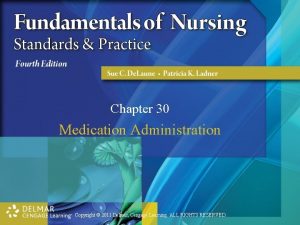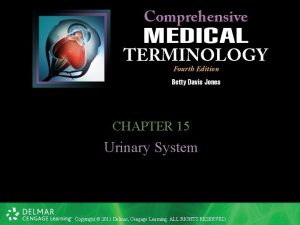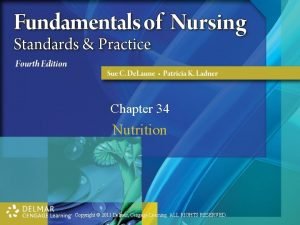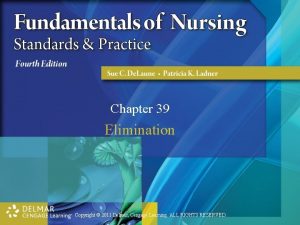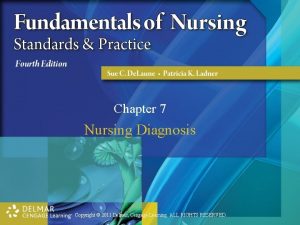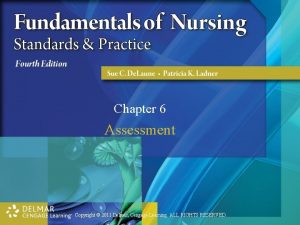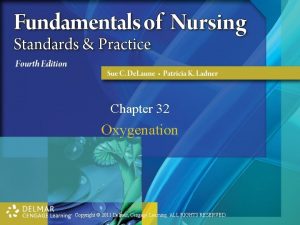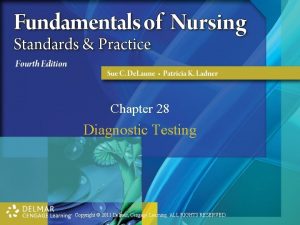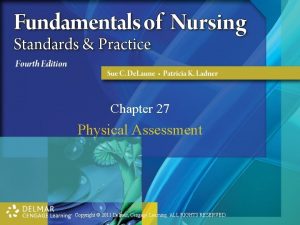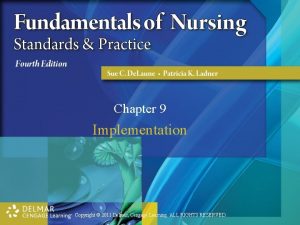Chapter 20 Cultural Diversity Copyright 2011 Delmar Cengage




















- Slides: 20

Chapter 20 Cultural Diversity Copyright © 2011 Delmar, Cengage Learning. ALL RIGHTS RESERVED.

Concepts of Culture • Culture – – – Blueprint for thinking and acting Learned and taught Shared Social in nature Dynamic and adaptive (continued) Copyright © 2011 Delmar, Cengage Learning. ALL RIGHTS RESERVED.

Concepts of Culture • Ethnicity and race – Cultural similarities – Biological similarities • Labeling and stereotyping – Inaccurate assumptions – Leads to conflict between nurses and clients of different cultures (continued) Copyright © 2011 Delmar, Cengage Learning. ALL RIGHTS RESERVED.

Concepts of Culture • Dominant values in U. S. : – – Achievement and success Individualism, independence, and self-reliance Activity, work, and ownership Efficiency, practicality, and reliance on technology (continued) Copyright © 2011 Delmar, Cengage Learning. ALL RIGHTS RESERVED.

Concepts of Culture • Dominant values in U. S. : – Material comfort – Competition – Youth and beauty Copyright © 2011 Delmar, Cengage Learning. ALL RIGHTS RESERVED.

Multiculturalism in the U. S. • By 2050: – Hispanics will make up 25 percent of population • Value of diversity – Differences due to ethnic, racial, and cultural variables (continued) Copyright © 2011 Delmar, Cengage Learning. ALL RIGHTS RESERVED.

Multiculturalism in the U. S. • Value of diversity – Provides new ideas, varying perspectives, and tolerance – May cause splitting, ethnocentrism, and discrimination – Nurses must honor diversity while understanding client’s perception and significance (meaning) of event (illness) Copyright © 2011 Delmar, Cengage Learning. ALL RIGHTS RESERVED.

Organizing Phenomena of Culture • Communication • Space • Orientation to time (continued) Copyright © 2011 Delmar, Cengage Learning. ALL RIGHTS RESERVED.

Organizing Phenomena of Culture • Social organization – Family • Linear • Collateral • Individualist (continued) Copyright © 2011 Delmar, Cengage Learning. ALL RIGHTS RESERVED.

Organizing Phenomena of Culture • Gender • Lifestyle • Religion Copyright © 2011 Delmar, Cengage Learning. ALL RIGHTS RESERVED.

Cultural Disparities in Health and Health Care Delivery • Vulnerable populations: – Indigent – Homeless • Environmental control • Folk medicine • Biologic variations Copyright © 2011 Delmar, Cengage Learning. ALL RIGHTS RESERVED.

Transcultural Nursing • Study of different cultures and subcultures with respect to cultural care, health beliefs, and practices • Goal: – Provide care within context of client’s culture (continued) Copyright © 2011 Delmar, Cengage Learning. ALL RIGHTS RESERVED.

Transcultural Nursing • Cultural competence – Providing nursing care appropriate to client’s cultural context – Requires knowledge about cultural values related to health and illness Copyright © 2011 Delmar, Cengage Learning. ALL RIGHTS RESERVED.

Cultural Competence and the Nursing Process • Elements required to provide culturally sensitive care: – – Self-reflection Facilitation of client choice Cultural knowledge Effective communication (continued) Copyright © 2011 Delmar, Cengage Learning. ALL RIGHTS RESERVED.

Cultural Competence and the Nursing Process • Assessment – – – Ethnic heritage Family Religious practices Food preferences Native language Social networks (continued) Copyright © 2011 Delmar, Cengage Learning. ALL RIGHTS RESERVED.

Cultural Competence and the Nursing Process • Assessment – Educational experiences – Family patterns of health care – Health care beliefs (continued) Copyright © 2011 Delmar, Cengage Learning. ALL RIGHTS RESERVED.

Cultural Competence and the Nursing Process • Diagnosis – Some may be culturally biased • • • Noncompliance Impaired verbal communication Impaired social interaction Deficient knowledge Disturbed thought processes Powerlessness (continued) Copyright © 2011 Delmar, Cengage Learning. ALL RIGHTS RESERVED.

Cultural Competence and the Nursing Process • Planning and outcome identification – To develop effective care plans, nurses need to understand cultural group’s perspectives on: • • Life processes How to maintain wellness Causes of illness Healers in cure and care of illness (continued) Copyright © 2011 Delmar, Cengage Learning. ALL RIGHTS RESERVED.

Cultural Competence and the Nursing Process • Implementation – Major nursing interventions: • Self-awareness • Use of nonjudgmental approach • Client education (continued) Copyright © 2011 Delmar, Cengage Learning. ALL RIGHTS RESERVED.

Cultural Competence and the Nursing Process • Evaluation – Affirm client strengths and potential for growth Copyright © 2011 Delmar, Cengage Learning. ALL RIGHTS RESERVED.
 Delmar cengage learning medical terminology
Delmar cengage learning medical terminology 2009 delmar cengage learning
2009 delmar cengage learning Chapter 1 matching medical terminology
Chapter 1 matching medical terminology Graphing tpr
Graphing tpr 2009 delmar cengage learning
2009 delmar cengage learning 2009 delmar cengage learning
2009 delmar cengage learning Chapter 10 cultural diversity
Chapter 10 cultural diversity Delmar cengage learning instructor resources
Delmar cengage learning instructor resources Cengage chapter 7
Cengage chapter 7 Chapter 9 cultural competence
Chapter 9 cultural competence Chapter 4 communication and cultural diversity
Chapter 4 communication and cultural diversity Sociology chapter 2: cultural diversity and conformity
Sociology chapter 2: cultural diversity and conformity Cultural diversity and conformity chapter test form a
Cultural diversity and conformity chapter test form a Examples of countercultures
Examples of countercultures Culturological assessment
Culturological assessment Chapter 4 communication and cultural diversity
Chapter 4 communication and cultural diversity Genetic diversity and biodiversity
Genetic diversity and biodiversity Genetic diversity vs species diversity
Genetic diversity vs species diversity Delmar isotonic
Delmar isotonic Delmar tsi
Delmar tsi Delmar cargo
Delmar cargo









